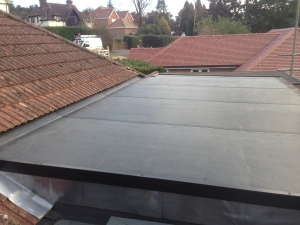Advantages and Disadvantages of Using Rubber Roofing Materials
While the use of rubber roofing materials have several advantages, it also has its disadvantages. We listed them below for the guidance of homeowners.
Advantages
Price. This is one of the biggest advantages of rubber roofing. The cost of installation is lower compared to other types of roof. Since the product is much lighter than other roofing materials like asphalt and slate shingles, the labor cost for installation is greatly reduced.
Longevity. Rubber roofing is known for their durability and long life span. Most rubber roofs are in the form of rolls that are laid over the roof. Depending on the actual shape and layout of the roof, few seams are found. Seams are where water normally seeps into the house causing damage to the interiors and integrity of the structure.
UV Resistant. Modern rubber roofs are resistant to ultraviolet rays of the sun, ensuring a long-lasting product that could last up to or beyond 50 years.
Durable. Compared to asphalt shingles that have the tendency to crack when exposed to extreme temperatures, strong winds and inadequate ventilation, rubber roofs are durable and resist damage when subjected to the same elements. Rubber roof resists strong winds and hail with a diameter of up to three inches.
Easy to Repair. On the rare occurrence that leaks occur, repairing the damaged rubber is easy and fast. A special tape manufactured to repair rubber is usually enough to restore the roof in prime condition. Sometimes a tube of liquid rubber is used with the same result.
Green. Most rubber roofs are made from recycled materials. The roofing material itself is recyclable after reaching the end of its lifetime. Compared to other roofing materials, the production of rubber roof requires less energy making it one of the greenest roofing materials around.
Fire Resistant. Rubber roofs are fire resistant similar to slate shingles. Unlike the latter, however, prices of rubber roofs are much lower. Starting a fire on a rubber roof is almost impossible. The fire-resistant quality of rubber roof means that you will have time call for help whenever fire occurs in your home.
Disadvantages
Dark Color. Most rubber roofs are black. Black roofs tend to absorb the sun’s heat and add to the temperature of the house or building. However, this can easily be negated by painting a white or light color on the rubber to make it cooler and prolong the life of the material.
Requires Professional Installation. A do-it-yourself person will not be able to lay down the rubber on his roof. Professional and licensed installers are required for the installation of rubber roofs. Finding a qualified installer may be a problem in some areas.
Improper Installation. To protect the house as it was meant to do, rubber roof must be properly installed by a professional. Problems could occur in the future because of incorrect installation, which might also void the warranty.
